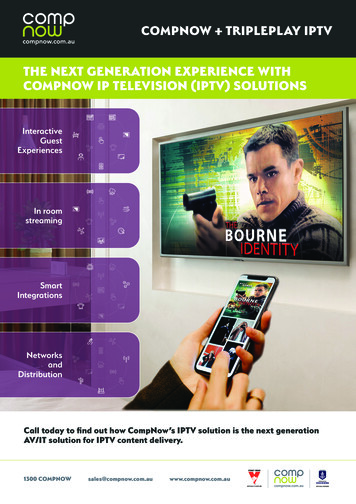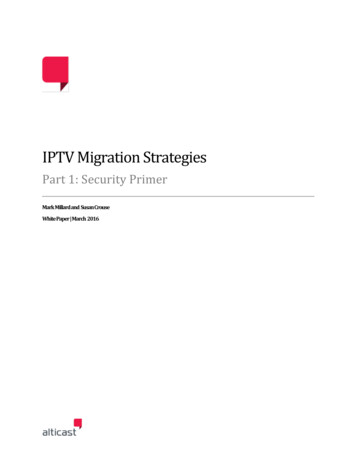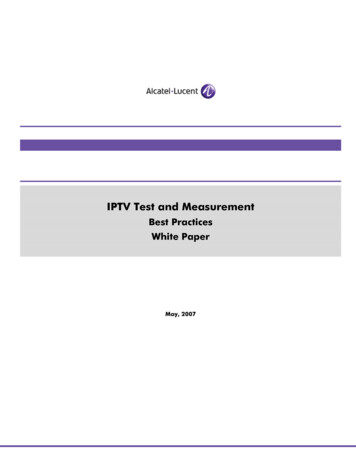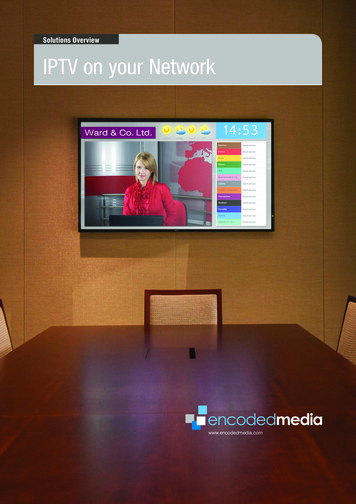
Transcription
Internet Protocol-based Television (IPTV) in Healthcare“Considerations for Implementing IPTV in Healthcare”BySherry Mettley, IT Director of InfrastructureApril 30, 2012INFSY 596 Independent StudiesVideo transmissions over IPConsiderations for Implementing IPTV in HealthcarePage 1
Internet Protocol-based Television (IPTV) in HealthcareThere are many driving forces for implementing Internet Protocol-based Television (IPTV) inHealthcare today. In February 2009, the American Recovery and Reinvestment Act (“the Stimulus Bill”)was signed into law by the Federal Government providing 27 billion under the Health InformationTechnology for Economic and Clinical Health Act (HITECH Act) providing a catalyst for implementingmany new technologies in the Healthcare enterprise. As we focus on meaningful use and patientoutcomes, one area that is proven to improve patient satisfaction is better television services thatengage, entertain and educate patients. Managing the patient experience with integrated patientapplications through television qualifies for ARRA meaningful use. (David W. Wright, 2011) In parallel,consumer demand for improved access to information anytime, anywhere, through any device istransforming how individuals watch television and access information. New Internet-based videostreaming services like AmazonPrime, HuluPlus, and NetFlix provide on-demand movies and videocontent. Individuals are also watchingfree internet video via YouTube, Facebook,Tweeter and other web sites causing ashift in how we are entertained andeducated. For example, 33 million moreviewers watched the Internet broadcast ofpuppies in a window than the premier of apopular TV Drama Madmen supportingthe theory that people are shifting thecontent they access from mainstream broadcasting to Internet-based content sources. (Marina Gorbis,2012)Healthcare organizations are challenged to meet the demands of consumers by providing hotel-likeamenities as hospitality and comfort are key ingredients to patient and customer satisfaction. InternetProtocol-based Television is evolving as the standard and healthcare organizations will need to embracethe technology and develop video patient services at the bedside to remain competitive and meet themeaningful use criteria for patient engagement. The driving forces to improve healthcare throughtechnology, meet consumer demands and standardize with the consumer video services industry,validate implementation of integrated IPTV solutions for the healthcare enterprise.Considerations for Implementing IPTV in HealthcarePage 2
Internet Protocol-based Television (IPTV) in HealthcareIPTV EvolutionTelevision is rapidly changing from digital broadcast services delivered by a carrier to ContentDelivery Networks. In the next 3-5 years, most home consumers will move away from traditional cable,satellite and telephone company television services to accessing Internet based content. Sometimesreferred to as over-the-top (OTT) video, it essentially uses the Internet as a transport pipe to deliver thecontent. This approach to video delivery has been extensively studied and is being standardizedthrough the combined work of the International Telecommunication Union-TelecommunicationStandardization Sector (ITU-T) and International Organization for Standards/InternationalElectrotechnical Commission (ISO/IEC) Joint Technical Committee (JTC1/SC29/WG11, also called theMotion Picture Engineering Group [MPEG]). The MPEG standards for video transmission have evolvedsince their introduction in the late 1980s to today. The ability to compress video images and stream richmedia content live or on demand over Internet to many devices, fixed or mobile, with the same reliablyand quality is revolutionizing the industry. (Khalid Ahmad and Ali C. Begen, Cisco, December 2009)The benefits for IPTV include lowering cable costs to install and distribute content overone common infrastructure, increasing flexibility to introduce applications with interactivecontent and providing ubiquitous access from any device and location. Today, the averagehomeowner pays about 2,000 annually for cable or satellite television services which arelimited to only viewing content in their home. Accessing IPTV content, individuals can accessfree or purchased content separate from their Internet provider and access it anywhere fromany Internet connected device. Applications and devices are being developed to allow theviewer to program content sources, rather than paying for hundreds of channels they neverwatch. Broadcast services like ABC, CBS, NBC, CNN, and local news stations stream theircontent from the Internet allowing devices like Warpia (warpia.com) or Roku (roku.com) tomanage an Internet channel guide menu system independent of the cable/satellite provider.Eventually, the cable and satellite providers will no longer have a need to provide broadcasttelevision. If you have access to the Internet, you can pick and choose your content and reducesubscription fees.Considerations for Implementing IPTV in HealthcarePage 3
Internet Protocol-based Television (IPTV) in HealthcareApplication in HealthcareAs we consider the possibilities for home IPTV to replace the broadcast carrier, like Comcastor DirectTV, what does this mean for large organizations in the hospitality industry? Since the1980s, hotels have been delivering on demand movies using Spectradyne like video contentsystems. The hotel industry was the first to push for more interactive capabilities and costeffective solutions for rich media distribution. As healthcare organizations strive to meet theneeds of patients similar to the hospitality industry, they will need to rely on IPTV to entertain,educate and interact with patients and their families.The value of IPTV to the healthcare organization goes beyond the cost effective method ofdistributing the content and the consumer desire to access any content on the Internet. Thereal power of IPTV is achieved by implementing a healthcare middleware application that willallow the patient to interact with a television display using the bedside Nurse Call systemremote control. This provides the patient and their family access to healthcare informationsystems and customized video content. Services could include assessing their pain using aninteractive chart, ordering discharge medication from the Pharmacy, displaying contactinformation of their care team including photos, watching physician prescribed educationalvideos, completing assessments regarding their understanding of the education, ordering foodservices or purchasing items from the gift shop. The list of possibilities is endless. Theseinteractive systems are customizable by age or individual to personalize the content available.A child could see a cartoon like game interface to play a game, call the nurse or browse theInternet with parental controls to protect them from inappropriate content. Longer staypatients can access Cyber School or online class materials to continue their education.Conversely, for older patients, the interface can be customized to be less complex and basic totheir needs. IPTV should provide a variety of broadcast-like channels, video on demand moviesand education, and access to the Internet. (Optimal Solutions and eVideon, 2012)Considerations for Implementing IPTV in HealthcarePage 4
Internet Protocol-based Television (IPTV) in HealthcareAnatomy of Healthcare IPTV SystemAt a high level, IPTV is processed in four major steps: (see Figure 1 below)1) Acquire the content signals from the Content Delivery Network or cable/satellite provider2) Encode the digital feed for IP transport3) Distribute the IPTV streams or signals over the healthcare enterprise network4) Decode the IPTV signal at the Set Top Box (STB) or an IPTV enabled TV (Smart TV)4321Figure 1(Optimal Solutions and eVideon, 2012)[1] In the Healthcare environment, we are expanding the use of IPTV to include the capturing oflive content on site and distribution of organizationally produced educational content available via Videoon Demand. These video sources along with a content delivery subscription-to a broadcast, satellite, orcable service are accessible through a common infrastructure. Cable and satellite providers are focusedon the home market, so a third party consultant or solution integrator is advisable to coordinate andinterface their service into the enterprise IPTV Head End. Live TV streams using a camera andstandalone encoder allow the organization to produce local content to stream live events occurring atthe hospital enabling patients who are too ill access to view from their hospital room. Video contentstored on the Video on Demand server including prerecorded events, education purchased fromConsiderations for Implementing IPTV in HealthcarePage 5
Internet Protocol-based Television (IPTV) in Healthcareprofessional sources or on demand movies from a provider like Swank Entertainment are accessiblethrough the system.[2] A major part of the IPTV infrastructure is the video encoder head end. A bank of encoders isrequired to convert the broadcast signal from base band RG6 to IP RJ45 for distribution on theenterprise network. A head end system distributing 150 to 300 channels may take up to 4communications racks. Since hospitals are extremely regulated and to ensure consistency for a reliablesystem, it’s best to follow standards and use high quality components. All IPTV streaming devices should be H.264/MPEG-4 part 10 AVC compliant. Video streaming and reception devices shall be compliant to Alliance for TelecommunicationsIndustry Solutions (ATIS) Standards All IPTV devices shall be HDCP compliant as applicable. All components must be UL-Listed. Underwriter Laboratories establishes safety standards formany industries.Some manufacturers that provide encoder bank of tuners include Cisco Digital Media Encoder,Motorola, Haivision, Visionary Solutions, Envivio 4Caster, and V-Brick HPS/XPS series. An encoder likethe one shown below is required for each digital channel to be converted to ip. To decode the ipchannel, a Set Top Box (STB) or integrated SmartTV is required that matches the encoder. For example ifyou use Visionary Solutions AVN443 (H.264 MPEG-4 Port 10/AVC) you need to have a STB that matchesit like the Amino A130.Figure 2: Visionary Solutions, Inc. AVN443 Channel encoder and Amino A130 Set Top BoxConsiderations for Implementing IPTV in HealthcarePage 6
Internet Protocol-based Television (IPTV) in HealthcareWhy standardize on H.264/MPEG-4/AVC?H.264/AVC is an industry standard for video compression. The H.264 standard is also known asMPEG-4 Part 10 and is a successor to earlier standards such as MPEG-2 and MPEG-4. It's an ITU standardfor compressing video based on MPEG-4 and is very popular, especially for high-definition video. AVCstands for Advanced Video Coding and it's identical to H.264. The compression achieved with MPEG-4and H.264 has reduced the bandwidth needed by 50% for equivalent quality of video as MPEG-2. Somecharacteristics of H.264 Advanced Video Codec include multiple reference frames for each compressedframe, spatial prediction of a macroblock based on adjacent blocks, deblocking filter to smooth outsharp transitions, weighted prediction to simplify widespread change in brightness such as a fade toblack, and improved techniques for compression including context adaptive variable length coding.These advancements collectively provide more flexibility for increased compression while retaining theimage quality. One of the most exciting aspects of this codec is the introduction of scalable profileswhich allows a decoder to process only a subset of the stream data to produce images that are scaled toa lower resolution, lower frame rates, or lower quality level then images in the original stream. Thisadvancement allows applications to drop down to lower resolution as bandwidth is limited withoutinterrupting the video flow. That is why this standard is considered the optimal for IPTV solutionsavailable in today’s market. (Simpson, 2008)IP Transport Considerations[3] One cannot propose to implement an IPTV system without evaluating the impact that thesetechnologies will have on the enterprise network. Decisions regarding the network topology, how toimplement multicast flows, management of video quality and how to monitor and troubleshoot the endto end video path are necessary to implement IPTV transport of the enterprise network. Videotransmission cannot be directly compared with voice or data traffic as it has much higher requirementfor bandwidth and is less tolerant of disruption. Distributing video over IP requires an entirely new setof tools, staff skills, configuration and potentially increased bandwidth. For these reasons, the networkdesign is a crucial element for a successful IPTV deployment. In many cases organization may approachthe network design as a hybrid or segregated network model rather than attempting to convergedvoice, data and video over one common converged enterprise network.Some of the considerations with transporting IPTV will require major configuration changes toyour enterprise network. The assumption is that the IP video transport path will be converged over theenterprise network rather than separated in its own physical network. Segregating the IPTV systemConsiderations for Implementing IPTV in HealthcarePage 7
Internet Protocol-based Television (IPTV) in Healthcaretraffic and maintaining an isolated local area network simplifies management, however limits the abilityto interface the patient with hospital systems. If the organization wants to gain the benefits of patientengagement and interface with other enterprise systems, a converged medical grade network isrequired. A hybrid approach may be possible using the base band coaxial RG6 cable distribution for thebroadcast/satellite TV distribution, while using the IP network to distribute the video on demandcontent and interface with hospital systems. This would eliminate the head end conversion for eachbroadcast channel but still require both coaxial RG6 and data RJ45 cable pulled to each STB/TV.Focusing on the enterprise network configuration, a quality of service (QoS) policy isrecommended. QoS will facilitate the prioritization of video and voice traffic across the network toreduce the likelihood of jitter, packet loss and full queues. Architecting and configuring queues forIPTV/IP flows may seem simple however packet behavior can be unpredictable. For example, take aconsistent flow of 3.75mb/s coming from a broadcast stream. Sometimes packets will bunch up causingthe queues to fill even though the offered load is limited. In this example under ideal conditions eachpacket carries a payload of 1316 bytes of video with a 2.8ms inter-packet gap. To further complicate thediscussion, consider a moderate IPTV deployment has 150 to 300 digital broadcast IPTV flow carriedover multicast IP. Add into that the video on demand flows transport as unicast IP. In order to ensurereliable performance of you IP network, you must be able to measure the burstiness of live flows,account for loss and establish a realistic test model for your video traffic with increasing network loads.If you have ample bandwidth you should not experience many problems, however it is better toevaluate before committing to the service. (Ineoquest Application Note)Figure 2: Basic model of 3 encoders with ideal 3.75Mb/s IP video flowsConsiderations for Implementing IPTV in HealthcarePage 8
Internet Protocol-based Television (IPTV) in HealthcareBandwidth requirements for IPTV Standard Definition streams are generally 4Mb/s per video flow,however high definition streams are going to consume at least twice that amount of bandwidth. If 300channels at 4mbps 1.2 Gb/s then one can expect that 300 High Definition channels at 15-20Mb/s willrequire 6 Gb/s. The minimum recommendation is 10G at the core and distribution levels of yournetwork.In addition to managing the quality of service over the enterprise network, there are severalother network management challenges. IPTV systems are evolving in the enterprise however there arevery few end to end single vendor solutions. With multiple vendors’ video components and elementmanagement systems such as the video head end, middleware, video on demand servers, securityservices like Certificate Authentication or Digital Rights Management equipment, ad splicers,multiplexers, etc., the complexity of troubleshooting an error or performance problem becomes verydifficult. Tools to monitor video quality from different parts of the network may be hard to find. Videotraffic requires a considerable amount of bandwidth demanding critical monitoring to avoid exceedingthresholds and mitigating network disruptions. It goes without saying that a robust, resilient andredundant enterprise network is needed to even consider this application. If the appropriate staff,network management tools, and rock solid network design are not available, video distribution over theenterprise network is not recommend. (Cisco Systems, Inc. , October 2009)Additionally, a prerequisite to distribute IPTV broadcast channels via the enterprise network isto understand and master multicast routing. For the sake of this discussion, CISCO’s network bestpractices are referenced as an example of how to implement multicast for IPTV. Multicast packets arereplicated in the network by routers and switches using multicast protocols. Two categories of Multicastprotocols are Internet Group Management Protocol (IGMP) and Protocol Independent Multicast (PIM). IGMP facilitates the User-to-Network requests with an IGMP join to request a multicast address.This industry-standard protocol manages IPv4 multicast group membership and dynamicallyregisters individual hosts in a multicast group on a particular network segment Each channel inour IPTV example is a single Multicast address. Every time a user changes the channel, the SetTop Box sends an IGMP leave and join to request the new channel. The access switches need tobe configured for IGMP snooping or this feature will not work correctly.Considerations for Implementing IPTV in HealthcarePage 9
Internet Protocol-based Television (IPTV) in Healthcare Network-to-Network requests use PIM which is the de-facto industry standard for buildingmulticast distribution trees. In most cases, the system uses the information learned from PIM toinstall shared-tree (*,G) and shortest-path tree (S,G) entries in the multicast routing table.Figure 2 Simple Multicast Example (Cisco Systems, Inc., 2007)In an enterprise network design, it is best to segregate multicast devices either in a VLAN orMPLS zone to simplify the management and configuration. Within a Layer 2 zone, the Set Top Boxrequests a channel by issuing an IGMP join to the access switch in the network. If the Access switch isalready broadcasting that channel to another device, the process is complete. If the channel is notavailable at the access switch, it issues a PIM join to the distribution switch or mrouter to request thechannel. In this way, a network access switch only broadcasts channels that are in use by the STBs ithosts reducing the need to broadcast all channels across the network. Most access switches will haveup to 48 ports so the maximum capacity needed at access switch for IP video is 192 Mb/s.Considerations for Implementing IPTV in HealthcarePage 10
Internet Protocol-based Television (IPTV) in HealthcareSet Top Box, In Room control devices and Healthcare Middleware[4]The Set Top Box or Smart TV decodes the H.264/MPEG-4/AVC ip transmission to display thechannel and video content at the patient’s bedside. Hospital- grade- TVs are required in healthcare forreliability, infection control and integration with other hospital systems. Whatever IPTV solution isselected, the in-room controls need to be compatible. Most Nurse Call systems include the pillowspeaker that controls changing channels and volume for the TV. These systems must be integrated withthe STB. Most of the healthcare focused IPTV installers understand this and are able to work with mostpopular systems.Android TVs like HCI are available that have built in H.264 decoders and do not require the STB.This is a cleaner design, but reliability issues have been reported. It’s not clear whether these areresolved in the company’s latest product line. Whether using a STB or Smart TV, the codec needs to beconsistent with the encoder technology used to convert the signal at the head end. IE: VisionarySolutions AVN443 recommend the Amino A310.The IPTV transmission is complete however; there are some additional considerations foroptimizing the use of an integrated IPTV system. The Office of the National Coordinator (ONC) forHealthcare and the Center for Medicare/Medicaid Services (CMS) are federal agencies that establishedthe guidelines for ARRA Meaningful use. It has been identified that by 2015, the meaningful usestandards are expecting organizations to offer: Patient-specific educational resources online in the common primary languages consistently forat least 20% of patients Access for all patients to a Personal Health Record (PHR) populated in real time with data fromEHRs [Outpatient, Inpatient] Patient self-management tools [Outpatient] Electronic assessments and reporting on the patient’s perception of their experience of care Capability to upload and incorporate patient-generated data (e.g., electronically collectedpatient survey data, biometric home monitoring data, patient suggestions of corrections toerrors in the record) into Electronic Health Records and clinician workflowToday, our electronic medical record does not offer patient facing, interactive resources toenable the direct communication expected. The flexibility and innovation available in some middlewaresolutions will provide patients the ability interface from their hospital bed using applications likeGetWellNetworks, Evideon and Magnet Health middleware applications. In addition to the patientservices, organizations will to track access to healthcare content and provide reports for these criteria toConsiderations for Implementing IPTV in HealthcarePage 11
Internet Protocol-based Television (IPTV) in Healthcareprove they have achieved these objectives. Healthcare system use HL7 – Health Level 7 standardinterfaces to present, track and update the patients’ interactions from in-room device(s). Whetherthat’s a TV with a STB, a Smart TV with Android operating system or a zero client flat panel display, thetime has come to move away from a traditional TV services limited to broadcasting digital TV servicesand establish video as an application over the enterprise network. This approach can become a majorpatient satisfier and help align our healthcare organization with the requirements for meaningful use in2015. (David W. Wright, 2011)It is clear that the movement towards IPTV that started over 30 years ago in the 1980s is finallytaking hold of our consumer and corporate video services. IPTV solutions seem complex, but are notinsurmountable. To support video transmission over IP, requires some adjustments, staff training,video resources and increased network requirements which aren’t trivial, but are manageable. Ifproviding high quality rich media content is a priority in the healthcare organization and there is acommitment to invest in the development of these patient engagement services, than IPTV is a logicalsolution. Not only will this service help inpatients, but the content developed can be made accessibleto patients at home or anywhere they have Internet connectivity. Mobile devices or home users canaccess these services which further improve our ability to meet the criteria for patient engagement andmeaningful use.Considerations for Implementing IPTV in HealthcarePage 12
Internet Protocol-based Television (IPTV) in HealthcareWorks CitedBenoit, H. (2008). digital television: Satellite, Cable, Terrestrial, IPTV, MObile TV in the DVB FrameworkThird Edition. Burlington, MA: Elsevier.Cisco Support. (2008, Dec 17). Multicast in a Campus Network: CGMP and IGMP Snooping. Retrieved 0412, 2012, from hes/ps708/products tech note09186a00800b0871.shtml?referring site bodynav#introCisco Systems, Inc. . (October 2009). IP Multicast Best Practices for Enterprise Customers. San Jose, CA:Cisco System, Inc. .Cisco Systems, Inc. (2007). Multicast Design for IPTV. San Jose, CA: Cisco Systems.Cisco Systems, Inc. (2007). Network Management Solution: Optimize Infrastructure for IPTV Services. SanJose, CA: Cisco Systems, Inc. .David W. Wright, M. (2011). Meaningful Use of Health Information Technology REQUIREMENTS ANDSOLUTIONS IN PATIENT AND FAMILY ENGAGEMENT. Bethesda, Maryland: GetWellNetwork, Inc.Ineoquest Application Note. (n.d.). Why IPTV/IP Video Transport is Different from Data and Voice.Mansfield, MA: IneoQuest Technologies, Inc.Khalid Ahmad and Ali C. Begen, Cisco. (December 2009). IPTV and Video Networks in the. IEEECommunications Magazine, 68-74.Marina Gorbis. (2012, April 16). Making Sense of the Great Content Shift. Retrieved April 19, 2012, fromNAB Show 2012: http://www.nabshow.com/2012/default.asp#3Optimal Solutions and eVideon. (2012). eVideon System Overview . Retrieved April 10, 2012, fromeVideon Healthcare: m-overview/Simpson, W. (2008). Video over IP. Oxford, UK: Focal Press.Considerations for Implementing IPTV in HealthcarePage 13
interrupting the video flow. That is why this standard is considered the optimal for IPTV solutions available in today's market. (Simpson, 2008) IP Transport Considerations [3] One cannot propose to implement an IPTV system without evaluating the impact that these technologies will have on the enterprise network.










